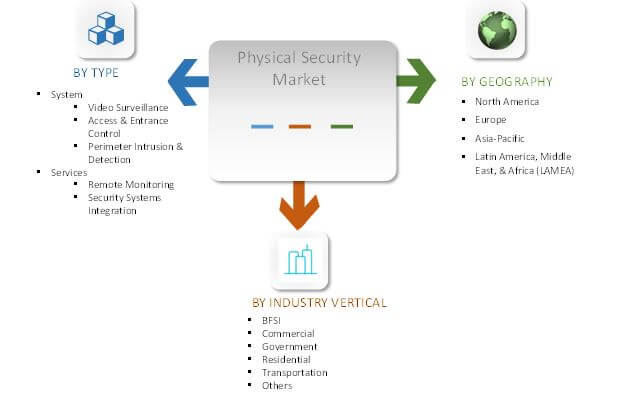Physical Security Market was valued at $78 billion in 2016 and is projected to reach at $153 billion by 2023, supported with a CAGR of 10.3%.
The advent of Internet of Things (IOT) has transformed the outlook of the global physical security market. Physical security comprises three essential elements, which include access control, surveillance, and testing. The physical sites are secured against attacks, accidents, or environmental disasters using locks, fencing, biometric access control systems, access control cards, and fire suppression systems. Physical locations are monitored by surveillance cameras and notification systems, including heat sensors, intrusion detection sensors, and smoke detectors. Disaster recovery procedures and policies requires periodic scrutiny to ensure better safety and reduce the time taken for recovering from disasters.
Inquiry Before Buying This Report: https://www.futureindustryinsight.com/product/physical-security-market/
Physical security includes protection of hardware, software, data, personnel, and networks against physical events and actions, which could potentially cause damage or loss to an organization. It safeguards organizations from natural disasters, fire, theft, vandalism, and terrorism. It uses multiple layers of interdependent systems, which include security guards, CCTV surveillance, locks, protective barriers, access control protocols, and other similar techniques.
The Asia-Pacific physical security market is poised to grow at a significant rate during the forecast period. Physical security services segment dominated the global market in 2016, and is expected to maintain its dominance in the near future. Furthermore, the other industry verticals including education, healthcare, retail, energy & utilities, and manufacturing, and industrial have dominated the global market, as these are the major prime end users of physical security.
The report focuses on the growth prospects and restraints of the market based on the analysis of regional trends. The study provides Porter’s five forces analysis of the industry to understand the impact of various factors such as bargaining power of suppliers, competitive intensity of competitors, threat of new entrants, threat of substitutes, and bargaining power of buyers on the growth of the market.
The physical security market comprises vendors such as Anixter International Inc., Tyco International PLC., Cisco Systems, Inc., Genetec Inc., ADT Corporation, Honeywell International, Inc., Bosch Security Systems, Inc., Stanley Security, and Senstar Corporation.
Segment Overview
The physical security market is segmented based on type, vertical, and region. Based on type, it is divided into system and service. Based on vertical, it is classified into banking, financial services, and insurance (BFSI); commercial; government; residential; transportation; and others (education, healthcare, retail, energy & utilities, manufacturing, & industrial).
The market is segmented based on region into North America, Europe, Asia-Pacific, and Latin America, Middle East & Africa (LAMEA) including the country-level analysis for each of these regions.
Physical Security Market Segmentation
Top Impacting Factors
According to our analysis of the impact of various factors on the global physical security market, the market is expected to be driven by increase in incidence of terror attacks, technological advancements, and growth in demand for such services in smart cities. However, privacy concerns and lack of physical & logical security integration are expected to hamper the market growth during the forecast period.
Surge in Terror Attacks
The government of various countries have increased their spending on physical security due to rise in terrorism and increase in security concerns, worldwide. Key government institutions, such as embassies, parliaments, courts, and government offices have focused on installing advanced video surveillance and access control systems. Newer technologies, such as drones, smart fence sensors, and mass notification systems (MNS) are used for surveillance at major events or assemblies in tier I cities. Moreover, several government agencies have implemented strict policies and guidelines for the installation of physical security systems. For instance, the US Government has enacted various laws, regulations, and industry guidelines such as Federal Information Security Act of 2002, Payment Card Industry Data Security Standard (PCI DSS), Privacy Act (5 U.S.C. 552a), and Integrated Physical Security Standards & Procedures (IPSSP) for security requirements.
Technological Advancements
The global physical security market has witnessed rapid growth since its inception with the advent of locks and keys. Technological advancements in wireless technologies and merger of physical & electronic spaces have facilitated greater adoption of physical security systems. Furthermore, the evolution of IoT and smart technologies is expected to play a role in improving physical security systems, including intelligent monitoring, remote network monitoring, perimeter protection, facial recognition, automobile tracking, iris recognition, and fingerprint scanning.
Increase in Demand of Physical Security in Smart Cities
Rapid urbanization in several countries across the globe over the past two decades has fueled the need for developing smart cities, which are managed by Internet of Things (IoT) and information & communication technology (ICT). Public security and emerging security services have been the key areas of focus for city administrators to ensure protection against crime, disasters, accidents, and epidemics. Furthermore, smart infrastructure are being integrated with smart security solutions, such as IP video wall, operator/administrative workstation, video management system, live image analytics, and detection & tracking services, as these are prone to cyber threats. Thus, increase in the number of smart cities is expected to boost the growth of the physical security market.
Key Benefits for Stakeholders
- This study includes the analytical depiction of the global physical security market along with current trends and future estimations to determine the imminent investment pockets.
- The report presents information regarding key drivers, restraints, and opportunities along with detailed impact analyses.
- The current market is quantitatively analyzed from 2014 to 2022 to highlight the financial competency of the industry.
- Porter’s five forces analysis illustrates the potency of buyers and suppliers in the physical security industry.
Physical Security Market Key Segments:
The physical security market is segmented on the basis of type, industry vertical, and geography…

